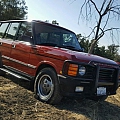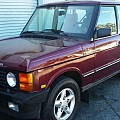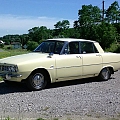The P6 was sixth and the last of the "P" designated Rover designs to reach production. The vehicle was marketed first as the Rover 2000 and was a complete "clean sheet" design intended to appeal to a larger number of buyers than earlier models such as the P4 it replaced. The P5 was sold alongside the P6 until 1973.
The 2000 was advanced for the time with a de Dion tube suspension at the rear four-wheel disc brakes (inboard on the rear) and a fully synchromesh transmission. The unibody design featured non-stressed panels bolted to a unit frame inspired by the Citroën DS.The de Dion set up was unique in that the "tube" was in two parts that could telescope and rotate thereby avoiding the need for sliding splines in the drive shafts with consequent stiction under drive or braking torque while still keeping the wheels vertical and parallel in relation to the body.
The Rover 2000 won industry awards for safety when it was introduced and included a carefully designed "safety" interior. One innovative feature was the prism of glass on the top of the front side lights. This allowed the driver to see the front corner of the car in low light conditions and also confirmed that they were operative.
One unique feature of the Rover 2000 was the unusual design of the front suspension system in which a bell crank (an L-shaped rotating bracket trailing the upper hub carrier joint) conveyed the vertical motion of the wheels to fore-and-aft-horizontally mounted springs fastened to the rear wall of the engine compartment. A single hydraulically damped arm was mounted on the firewall for the steering.The front suspension was designed to allow as much width for the engine compartment as possible so that Rover's Gas Turbine engine could be fitted. In the event the engine was never used for the production vehicle but the engine compartment width helped the accommodation of the V8 engine adopted years after the car's initial launch for the 2000.
The luggage compartment was limited in terms of usable space because of the "base unit" construction complex rear suspension and in series II vehicles the battery location. Lack of luggage space (and hence the need to re-locate the spare tyre) led to innovative options for spare tyre provision including boot lid mountings and optional Dunlop Denovo run-flat technology.
The car's primary competitor on the domestic UK market was the Triumph 2000 also released in October 1963 just one week after the Rover.[3] In continental Europe the Rover 2000 contended in the same sector as the Citroen DS which like the initial Rover offering was offered only with a four-cylinder engine– a deficiency which in the Rover was resolved four years after its launch when Rover's compact V8 was engineered to fit into the engine bay. The Rover 2000 interior was never as spacious as those of its Triumph and Citroen rivals especially in the back where its sculpted two-person rear seat implied that Rover customers wishing to accommodate three in the back of a Rover should opt for the larger and older Rover 3 Litre.
 1993 Land Rover Range Rover LWB County 4.2 LSE Very Hard to Find Vintage Rover!
1993 Land Rover Range Rover LWB County 4.2 LSE Very Hard to Find Vintage Rover!
 1991 Land Rover Range Rover Classic. Suspension upgrade
1991 Land Rover Range Rover Classic. Suspension upgrade
 1992 Land Rover Range Rover 2 Owner California Vehicle Rust Free No Reserve
1992 Land Rover Range Rover 2 Owner California Vehicle Rust Free No Reserve
 1994 LAND ROVER RANGE ROVER COUNTY CLASSIC W/ WORKING EAS 3.9L SHORT WHEELBASE
1994 LAND ROVER RANGE ROVER COUNTY CLASSIC W/ WORKING EAS 3.9L SHORT WHEELBASE
 Family owned British Rover 2000 TC with 65,423 original miles. Beautiful !
Family owned British Rover 2000 TC with 65,423 original miles. Beautiful !